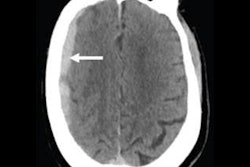
Providing around-the-clock radiologist coverage significantly boosted the efficiency of emergency patient care, including reducing head CT turnaround times by more than tenfold, according to a series of presentations at the upcoming Canadian Association of Radiologists (CAR) 2019 meeting in Montreal.
 Sabeena Jalal from Vancouver General Hospital.
Sabeena Jalal from Vancouver General Hospital.Researchers from Canada evaluated the effect of implementing 24/7 radiologist coverage at a level I trauma center during a period in which more than 50,000 patients presented to the hospital emergency department. They found that having an onsite staff radiologist available at all hours dramatically decreased the turnaround time of emergency head CT exams, and it also led to statistically significant reductions in patient length of stay and hospital admissions.
The study data suggest that 24/7 radiologist coverage addresses some of the healthcare industry's most talked-about issues, such as improving patient value, reducing physician burnout, and lowering costs, presenter Sabeena Jalal, a research fellow at Vancouver General Hospital, told AuntMinnie.com.
"24/7 onsite staff emergency radiologist coverage resulted in more acute patients moving faster through the emergency department," she said. "This results in reduced turnaround time, which, in turn, reduces the length of stay in the emergency department and, hence, the wait times. People needing care urgently can get the right care without delay."
24/7 radiologist coverage
The demand for emergency medical imaging -- especially CT exams -- has risen exponentially over the past decade, with no signs of slowing down. Many of these exams are requested after the standard day shift, requiring radiologists to interpret scans under circumstances that are less than ideal, noted principal investigator Dr. Savvas Nicolaou.
"Waking up the radiology specialist at 2 a.m. or 3 a.m. and asking them to look at 5,000 images is no different than waking up a pilot and telling them to be fresh and attuned right away," he said.
Policymakers have, in response, implemented various strategies to optimize emergency imaging in recent years. One such method at Vancouver General Hospital has been to institute 24/7 staff radiologist coverage for emergency imaging exams.
To assess the value of a 24/7 radiology service, Jalal and colleagues examined approximately 6,000 head CT scans of patients who presented to the hospital with head trauma before the service began (from March to September 2013) and after it was implemented (from September 2014 to March 2015). The pre- and post-24/7 radiologist coverage patient populations had comparable age and gender distributions.
The researchers calculated the amount of time that passed between when a head CT exam was acquired and initially interpreted (turnaround time 1), as well as the time between when the radiology report was transcribed and finalized (turnaround time 2).
When they compared the periods, they found statistically significant reductions in both categories of turnaround time after the implementation of 24/7 onsite staff radiologist coverage for the emergency department (p < 0.0001). These differences applied to men and women across all age groups.
| Emergency care before and after 24/7 onsite radiologist coverage | ||
| Mean | Pre-24/7 service | Post-24/7 service |
| Head CT interpretation turnaround time | 9 hours, 38 minutes | 54 minutes |
| Head CT final report turnaround time | 26 hours, 17 minutes | 2 hours, 1 minute |
| Emergency department length of stay (CTAS 1 patients) | 3 hours, 52 minutes | 3 hours, 27 minutes |
| Percentage of patients admitted | 20.71% | 19.16% |
All differences were statistically significant.
Downstream benefits
The group also discovered that the rate of discrepancies observed in emergency radiology reports for head CT exams fell from roughly 11% in the pre-24/7 radiologist coverage period (only 4% for major discrepancies) to less than 1% after the service was implemented.
Expanding the scope of the study, Jalal and colleagues also investigated the extent to which the 24/7 radiology service improved other aspects of emergency care. They found that the service led to statistically significant reductions in the amount of time patients spent in the emergency department, particularly for those who were classified as a 1 or 2 using the Canadian Triage and Acuity Scale (CTAS). They also found that the service decreased the proportion of patients admitted for additional care at the hospital.
"Timely diagnosis helps emergency room doctors decide about the surgical or medical intervention as soon as possible -- thus improving turnaround times, length of stay in the emergency department, and patient outcomes," Jalal said.
The researchers estimated that the implementation of the 24/7 emergency radiology schedule, split into three distinct shifts, is cost-neutral for the hospital.
"The 24/7 service model is one tailor-made for the acute setting that emphasizes a strong clinician-radiologist, team-based approach and an 'on-demand' prioritization of cases in order to maximize patient survival and outcomes," she said. "It is completely different from the traditional 'request-schedule' model commonplace elsewhere in radiology. It is focused on the integrated care of the acute patient."



















